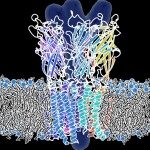Link to Pubmed [PMID] – 7664121
Link to HAL – Click here
Link to DOI – https://doi.org/10.1038/nsb0795-537
Nat Struct Biol. 1995 Jul;2(7):537-47.
The crystal structure of phenylalanyl-tRNA synthetase from Thermus thermophilus, solved at 2.9 A resolution, displays (alpha beta)2 subunit organization. Unexpectedly, both the catalytic alpha- and the non-catalytic beta-subunits comprise the characteristic fold of the class II active-site domains. The alpha beta heterodimer contains most of the building blocks so far identified in the class II synthetases. The presence of an RNA-binding domain, similar to that of the U1A spliceosomal protein, in the beta-subunit is indicative of structural relationships among different families of RNA-binding proteins. The structure suggests a plausible catalytic mechanism which explains why the primary site of tRNA aminoacylation is different from that of the other class II enzymes.

